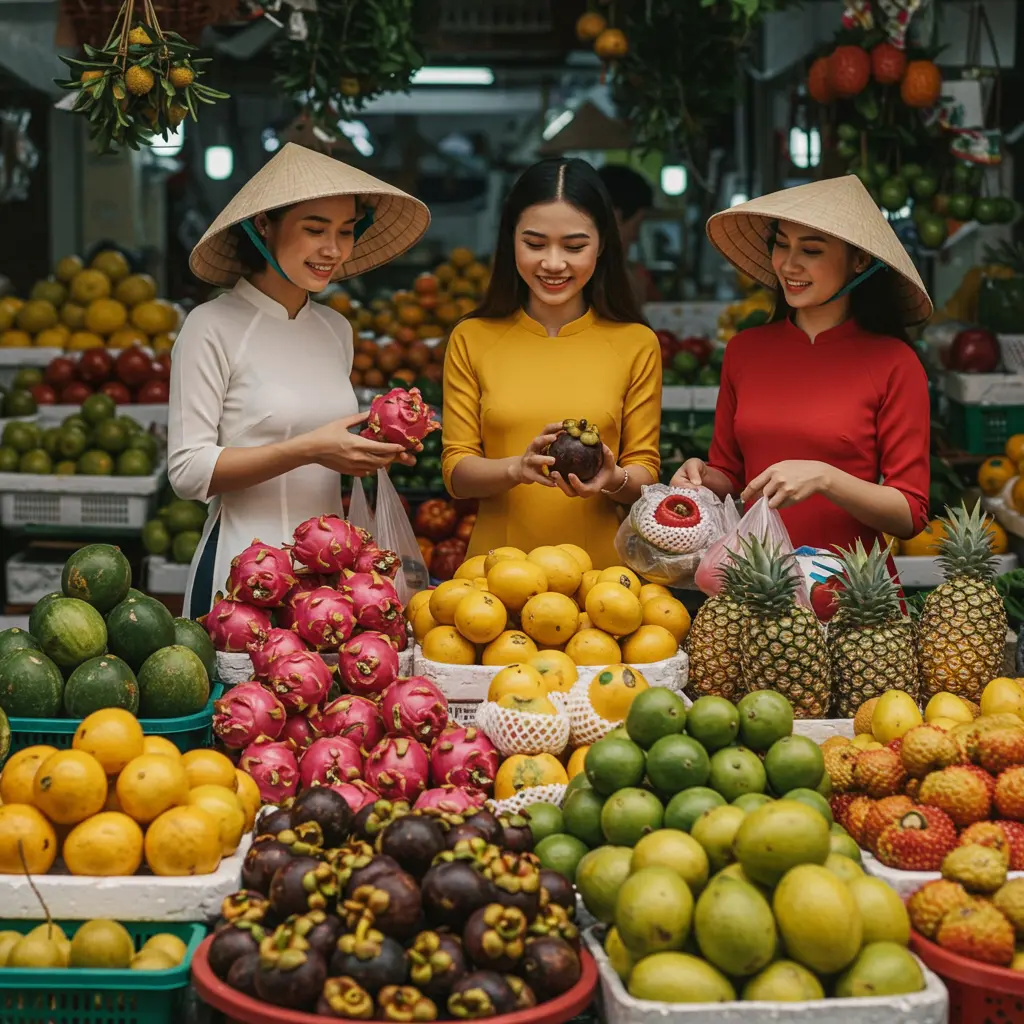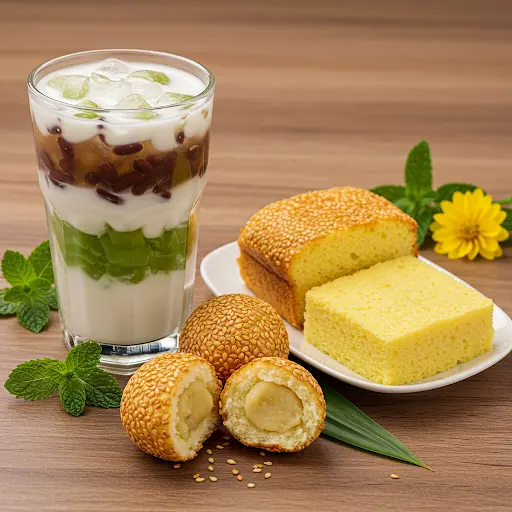Vietnamese food noodles form a vital pillar of Vietnamese Cuisine, a topic explored in depth on essentialvietnamtravel.com.. This diverse category is more than food; it’s a portal into Vietnam’s culture, history, and regional tastes. From aromatic soup bowls to vibrant noodle salads, Vietnamnoodles embody Southeast Asian Cuisine while holding a distinct place in World Cuisine. Understanding these vietnamese noodle dishes reveals complex aromas, satisfying textures, and the soul of Vietnamese cooking.
Many perceive vietnamese noodle dishes as complex. This guide simplifies them. We will explore famous varieties, understand their core elements, locate authentic versions, and guide you through making a classic bowl at home. EssentialVietNamtravel.com offers this guide based on deep experience exploring Vietnamese food. We prioritize facts and clear instructions. Prepare to explore the world of noodles in Vietnamese cooking, covering everything from Pho to Bun Bo Hue.
Exploring the Delicious World of Vietnamese Noodles: Understanding Pho, Bun (Rice Vermicelli), Mi Quang, and Other Noodle Soups

The range of vietnamese food noodles is vast. While Pho gains global fame, it’s one element in a rich tapestry of vietnamese noodle dishes. Knowing the main types is key to appreciating the depth and Regional Variations and Geography within Vietnamese Cuisine. The main difference often lies in the Noodles used and the accompanying Broth or sauce. Let’s examine the most popular noodle dish from vietnam, including Pho, versatile Bun (Rice Vermicelli), distinctive Mi Quang, and other regional stars.
Each noodle dish vietnam presents a unique Savory Flavor Profile. Learning the types of vietnamese noodles builds confidence for navigating menus and recipes, enhancing exploration of Asian Cuisine. Remember, Rice flour is the base for the most common types of Vietnamese noodles, yielding great textures. Authenticity in preparation is often sought after by consumers/diners seeking genuine Vietnam noodles.
Pho: The Iconic Vietnamese Noodle Soup
Pho is a quintessential Vietnamese Noodle Soup, perhaps the most recognized noodle dish from vietnam. Its essence is a meticulously simmered, fragrant Broth. Two primary forms exist: Pho Bo and Pho Ga.
(Pho Bo – Main Protein – Beef): This version uses Beef. The Broth Base is typically Beef Bone, simmered for hours with charred onion, ginger, and Key Spices like Star Anise, Cinnamon, Clove. This creates a complex, savory, subtly sweet flavor. Thin beef slices, served rare (Pho Tai), well-done (Pho Chin), or as meatballs (Pho Bo Vien), are added before serving.
(Pho Ga – Main Protein – Chicken): Pho Ga uses Chicken. The Broth Base involves simmering Chicken Bone and meat, yielding a lighter but flavorful soup, typically topped with shredded chicken.
Both types use (Pho Bo – Noodle Type – Flat Rice Noodles) (“banh pho”), soft Rice Noodles that absorb the Broth. Pho’s Origin is linked to Northern Vietnam, specifically Hanoi, early 20th century. Serving involves placing noodles, then protein, then pouring hot broth over. Fresh Herbs Garnish (basil, cilantro, mint), bean sprouts, Lime, and chili are served alongside for customization. The distinctive Pho bowl shape and Steam rising from a bowl symbolize this beloved dish, a star of Vietnamese Cuisine.
Bun (Rice Vermicelli): Versatile Noodles in Soups and Salads
Bun (Rice Vermicelli) are thin, round Rice Noodles, incredibly adaptable in vietnamese food noodles. Unlike Pho’s flat noodles, Bun offers a different texture for numerous vietnamese noodle dishes, including soups and drier salads. These Noodles are staples across Vietnam.
Bun Bo Hue is a famous example. (Bun Bo Hue – Origin – Hue), this central Vietnamese soup uses (Bun Bo Hue – Noodle Type – Thick Round Rice Vermicelli), thicker and chewier than standard bun.
The Broth is robust, with (Bun Bo Hue – Main Protein – Beef Shank, Pork Hock) and flavored distinctly by (Bun Bo Hue – Key Flavor – Lemongrass, Fermented Shrimp Paste). This creates a unique savory, umami, often (Bun Bo Hue – Spice Level – Spicy) profile. Some versions Contain Congealed Blood. Searching “bun bo hue spicy beef noodle soup near me” targets this complex taste.
Bun Cha, with (Bun Cha – Origin – Hanoi), features (Bun Cha – Noodle Type – Thin Rice Vermicelli) beside (Bun Cha – Main Protein – Grilled Pork Patties/Slices) and dipping sauce (Nuoc Mam Pha). The (Bun Cha – Serving Style – Dipping Sauce with Noodles/Herbs Separate) involves dipping noodles, pork, and herbs.
Other varieties include Bun Rieu (crab soup), Bun Thit Nuong (grilled pork, often Served Dry/Without Broth), or Bun Cha Gio (fried spring rolls). Bun shows the flexibility of vietnamese noodles types. Vegetarian vietnamese vermicelli noodle bowl recipe options also exist.
Mi Quang: Turmeric Noodles from Central Vietnam
Mi Quang is a unique noodle dish vietnam from Quang Nam province, Central Vietnam. It’s recognized by its (Mi Quang – Noodle Type – Wide Yellow Turmeric Noodles). These Rice Noodles, infused with turmeric, have a vibrant color and subtle flavor.
Unlike Pho, Mi Quang features (Mi Quang – Broth Amount – Minimal/Shallow). A small amount of intense pork or shrimp broth concentrates the flavor. Generous garnishes are key. (Mi Quang – Key Garnish – Rice Cracker, Peanuts) provide essential crunch and richness. Pork, shrimp, quail eggs, lettuce, banana blossoms, and Herbs are common toppings, creating Variable Textures.
Mi Quang exemplifies Regional Vietnamese Cooking Styles and unique vietnamese noodles types, offering a satisfying, less soupy popular noodle dish from vietnam.
Other Notable Vietnamese Noodle Varieties (Cao Lau, Banh Canh)
Beyond the main types, Vietnamese Cuisine includes other intriguing vietnamese food noodles like Cao Lau and Banh Canh.
Cao Lau is tied to (Cao Lau – Origin – Hoi An). The history of cao lau noodles Hoi An specialty mentions unique production. Authentic (Cao Lau – Noodle Type – Chewy Ash-Water Treated Noodles) supposedly use water from a specific well and local tree ash, yielding uniquely chewy noodles, unlike any other noodle in vietnamese cooking.
It’s Served Dry/Without Broth, with minimal sauce, pork, and greens. (Cao Lau – Key Garnish – Crispy Pork Rind, Croutons) add signature crunch. This dish Features Unique Regional Noodle Types.
Banh Canh encompasses soups defined by (Banh Canh – Noodle Type – Thick Tapioca/Rice Flour Noodles). These Noodles (tapioca, rice, or blend) create a (Banh Canh – Noodle Texture – Chewy, Slippery) feel. Broth varies regionally (pork, seafood, fish cake). The thick noodles make it heartier than Pho or Bun. It’s a comforting Vietnamese Noodle Soup enjoyed nationwide, showing further diversity in vietnamese noodle dishes.
The Soul of Vietnamese Noodles: The Importance of Broth and Fresh Herbs
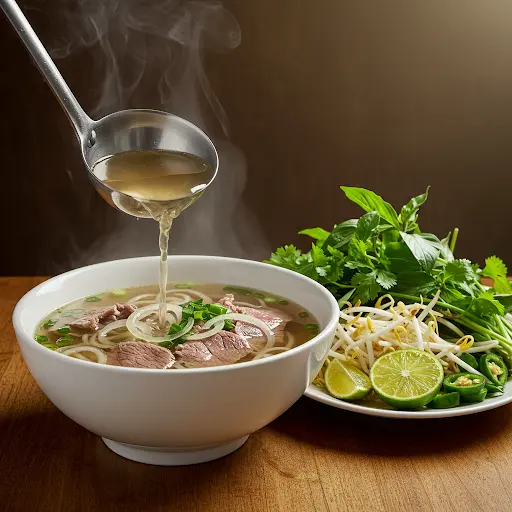
What elevates vietnamese food noodles? Two elements: the meticulously made Broth (in soups) and abundant Fresh Herbs. These aren’t extras; they’re fundamental to the Savory Flavor Profile and experience within Vietnamese Cuisine. Vietnamese noodle dishes are known for complex and appealing flavors/aromas, largely due to these.
The Emphasis on Balance of Five Flavors (sweet, sour, salty, bitter, spicy) is often achieved via broth, protein, noodles, herbs, and seasonings like Fish Sauce (Nuoc Mam). This focus on freshness and balance distinguishes Vietnam noodles within Asian Cuisine and World Cuisine. Understanding this is key to appreciating the flavor depth, often enjoyed with Chopsticks.
Why the Broth is Key in Dishes like Pho
The Broth in Vietnamese Noodle Soup, especially Pho, is the dish’s foundation. Achieving Distinctive Clear, Complex Broths demands patience and technique, reflecting traditional Culinary Preparation Techniques. For Pho Bo, this involves simmering Beef Bone for hours (up to 12) with charred aromatics and spices like Star Anise, Cinnamon, Clove. Skimming ensures clarity. For Pho Ga, Chicken Bone yields a lighter broth.
This slow process extracts deep flavors. Many popular Vietnamese noodle dishes involve a carefully simmered broth. Broth quality defines Pho quality – clear, fragrant, balanced. Tasting authentic Pho reveals the broth’s complexity. The Steam rising from a bowl signifies this careful craft. This dedication marks great vietnamese food noodles.
The Role of Fresh Herbs and Garnishes
Vietnamese markets overflow with fresh greens. This Generous Use of Fresh, Uncooked Herbs as Garnish defines vietnamese food noodles and Vietnamese Cuisine. They’re integral to flavor and texture. Platters with Pho or Bun include Herbs like Thai basil, cilantro, mint, culantro, plus crunchy Bean Sprouts, chili, and tangy Lime wedges. (Vietnamese Noodle Soup – Common Garnish – Bean Sprouts, Lime Wedge, Fresh Herbs) are standard.
This practice Utilizes Fresh Herbs for bright notes cutting through richness. They add aroma, freshness, and aid the Balance of Five Flavors. Variable Textures improve (crisp sprouts, tender herbs). Freshness of ingredients, particularly herbs, is highly valued. Adding them just before eating maximizes flavor. This interactive element allows diners to customize, personalizing each bowl within traditional Vietnam noodles. This is central to Vietnamese Street Food Culture.
Finding Authentic Vietnamese Noodle Soup: Tips for Locating Great Restaurants
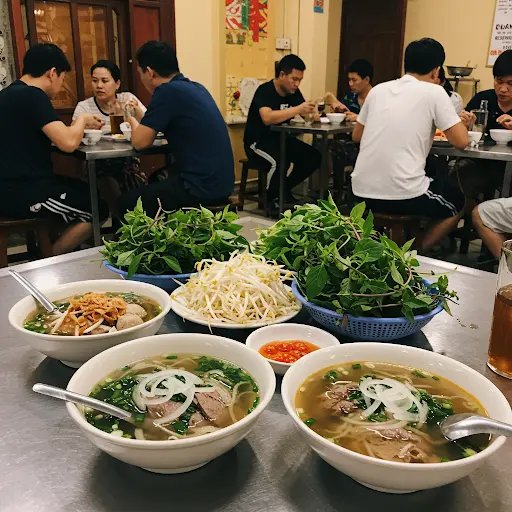
Understanding the basics leads to seeking authentic vietnamese food noodles. The User wants to find a place nearby that serves Vietnamese noodles, a common search intent. Finding great Vietnamese Noodle Soup outside Vietnam takes some effort but offers rewarding experiences. Authenticity relies on traditional Culinary Preparation Techniques and Ingredient Sourcing and Quality.
Look past fancy settings. Often, the best Pho or Bun Bo Hue is in simple places popular with Vietnamese people – a good sign of authenticity. Check the menu: does it specialize in a few noodle dish vietnam types, or try covering all Asian Cuisine? Specialization suggests Expertise. Ask locals or check online reviews mentioning authenticity or comparing to experiences in Vietnam (mentioning Hanoi or Ho Chi Minh City).
Observe the Broth if possible – clarity and aroma matter. Cloudy broth may indicate shortcuts. Is a generous plate of Fresh Herbs Garnish provided? Commitment to fresh ingredients is key. Try places specializing in Mi Quang or Cao Lau if available – it shows dedication to Regional Vietnamese Cooking Styles. Use specific search terms like “best pho restaurant near me” or “bun bo hue spicy beef noodle soup near me”. Trustworthy reviews often cover broth quality, herb freshness, and meat tenderness (Beef or Chicken). Exploration is needed, but these tips help.
Crafting Your Own Vietnamese Noodle Dish: Starting with Classic Pho with Beef
Making vietnamese food noodles at home offers deep appreciation. The User wants to find instructions to make a specific Vietnamese noodle dish at home drives many searches. While mastering every noodle dish vietnam takes time, starting with iconic Pho Bo (Pho with Beef) is achievable. This section gives clear steps, following EssentialVietNamtravel.com’s practical focus, aiming for 90% success.
We cover making the Broth, preparing Rice Noodles and toppings, and assembly. A “best pho recipe authentic vietnamese slow cooker” can simplify broth, but stovetop simmering builds flavor. Adhering to food safety (YMYL) is crucial.
Simmering the Perfect Broth
Pho Bo’s heart is its Broth. This needs time and quality ingredients. Use 2-3 kg (Pho Bo – Broth Base – Beef Bone) (knuckle/marrow). Rinse well. Parboil bones (5-10 min), discard water, rinse again for clear broth. Place bones in large stockpot (10-12L). Add 1-2 large charred onions and 100g charred ginger (char over flame, broiler, or dry pan).
Add charred aromatics to pot. Cover bones with cold water (6-8L). Bring to gentle boil, reduce to low simmer. Skim scum diligently first hour for clarity. Add (Pho Bo – Key Spices – Star Anise, Cinnamon, Clove) (typically 4-5 star anise, 1 cinnamon stick, 4-5 cloves, optionally 1 black cardamom, 1 tsp coriander seeds – toast briefly first). Add salt, optional rock sugar. Simmer gently, uncovered/partially covered, 6+ hours (ideally 8-10). Strain carefully (use cheesecloth-lined sieve for extra clarity). Season with quality Fish Sauce (Nuoc Mam) and salt. This is your authentic Pho base.
Preparing the Rice Noodles and Toppings
While broth simmers, prep other items. For Pho Bo, use (Pho Bo – Noodle Type – Flat Rice Noodles) (dried). Follow package: soak warm water (~30 min), boil briefly (15-30 sec) until tender-firm. Drain, rinse cold water. Toss lightly with oil. For Beef, use tender cuts (sirloin, flank). For (Pho Tai – Main Protein – Beef) (rare), slice raw beef very thin against grain (partially freezing helps).
For (Pho Chin – Main Protein – Beef) (well-done), simmer larger brisket/flank pieces in broth last 1-2 hours, remove, slice. Prep garnishes: wash/pick Fresh Herbs Garnish (basil, cilantro, mint), wash bean sprouts, slice onions thinly (optional soak), slice chilies, cut Lime wedges. These Key Vietnamese Ingredients are vital.
Assembling Your Bowl
Assembly brings your vietnamese food noodles together. Warm serving bowls (Pho bowl shape ideal) with hot water. Place portion of cooked Rice Noodles in bowl. Arrange chosen Beef over noodles (Pho Tai raw slices flat; Pho Chin or Pho Bo Vien neatly).
Ensure Broth is boiling. Ladle hot broth over beef/noodles (cooks Pho Tai). Be generous. Watch Steam rising from a bowl. Serve immediately with garnish platter (Herbs, sprouts, Lime, chili). Diners add garnishes using Chopsticks. This respects Cultural Significance and Rituals of eating Pho.
What Makes Each Vietnamese Noodle Dish Unique? Exploring Variations like Pho Tai
The allure of vietnamese food noodles extends beyond major dishes like Pho, Bun, or Mi Quang to subtle internal variations and strong Regional Variations and Geography. Understanding these nuances deepens appreciation for the History of Vietnamese Cuisine.
For example, specific preparations like (Pho Tai – Main Protein – Beef) offer different textures than (Pho Chin – Main Protein – Beef). Pho Tai uses thin raw beef cooked instantly by hot broth, yielding tender meat, contrasting with Pho Chin’s simmered tenderness or (Pho Bo Vien – Main Protein – Beef)’s chewiness. These are specific ways of preparing a Part-Of classic Pho.
Regional identity is strong. (Bun Bo Hue – Origin – Hue) tastes unlike soups from Hanoi or Ho Chi Minh City due to its signature Lemongrass and Fermented Shrimp Paste (Includes Fermented Elements) base and Spice Level – Spicy. (Cao Lau – Origin – Hoi An) epitomizes Strong Regional Identity and Variation of Dishes, with its Features Unique Regional Noodle Types tied to local water/ash. (Bun Cha – Origin – Hanoi), with Grilled Pork Patties/Slices and Dipping Sauce, feels Northern. Even Nuoc Mam (Fish Sauce) varies regionally.
Differences highlight Emphasis on Balance of Five Flavors interpreted uniquely across Vietnam. Exploring variations like Pho Tai or regional dishes reveals incredible depth within vietnamese noodle dishes. Rarer versions might Incorporate Game Meat or Offal.
Essential Ingredients for Authentic Flavor: Finding Quality Rice Noodles, Fish Sauce, and Herbs
Authentic homemade vietnamese food noodles depend heavily on Ingredient Sourcing and Quality. The User is looking for specific ingredients or brands related to making the dishes intent highlights this. Technique matters, but starting with correct Rice Noodles, Fish Sauce (Nuoc Mam), and Fresh Herbs is crucial. These Key Vietnamese Ingredients underpin countless vietnamese noodle dishes. Sourcing might require visiting an Asian market.
Choosing the Right Rice Noodles
Using the correct Rice Noodles is vital. vietnamese noodles types vary:
- Flat Rice Noodles (Banh Pho): For (Pho Bo – Noodle Type – Flat Rice Noodles) / (Pho Ga – Noodle Type – Flat Rice Noodles). Choose medium width dried noodles.
- Thin Rice Vermicelli (Bun): For (Bun Cha – Noodle Type – Thin Rice Vermicelli), Bun Thit Nuong, Bun Cha Gio. Round, thin.
- Thick Round Rice Vermicelli: For (Bun Bo Hue – Noodle Type – Thick Round Rice Vermicelli). Thicker, chewier.
- Wide Yellow Turmeric Noodles: Signature (Mi Quang – Noodle Type – Wide Yellow Turmeric Noodles). Distinct color/width.
- Chewy Ash-Water Treated Noodles: Unique (Cao Lau – Noodle Type – Chewy Ash-Water Treated Noodles). Hard to find outside Hoi An.
- Thick Tapioca/Rice Flour Noodles: For (Banh Canh – Noodle Type – Thick Tapioca/Rice Flour Noodles). Often fresh/frozen. Texture: (Banh Canh – Noodle Texture – Chewy, Slippery).
Check package instructions. Using correct noodle in vietnamese terms helps. Rice flour is the base for the most common types of Vietnamese noodles.
Understanding Nuoc Mam (Fish Sauce)
Fish Sauce (Nuoc Mam) plays a Fundamental Role of Fish Sauce (Nuoc Mam) for Seasoning in Vietnamese Cuisine, especially vietnamese food noodles, providing saltiness and umami. Quality varies. Look for anchovy/salt only ingredients. Good sauce is clearer, less pungent (Red Boat, Three Crabs common brands). Nuoc Mam is used in cooking (Broth) and as (Nuoc Mam Pha – Base Ingredient – Fish Sauce) for dipping sauce.
Learning how to make vietnamese fish sauce dipping sauce for noodles (Nuoc Mam Pha) is key – dilute fish sauce with water, sugar, Lime/vinegar, garlic, chili. The (Nuoc Mam Pha – Role – Dipping Sauce/Dressing) is vital for Bun Cha, etc. Good fish sauce elevates dishes.
Sourcing Fresh Herbs and Spices
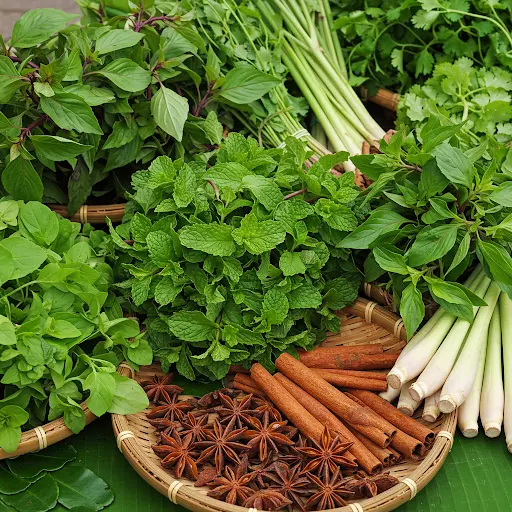
Generous Use of Fresh, Uncooked Herbs as Garnish requires fresh ingredients. Asian markets offer Thai basil, culantro, Vietnamese mint beyond standard cilantro/mint. Freshness of ingredients, particularly herbs, is highly valued. Look for vibrant leaves.
Store properly. Key Spices for broths (Star Anise, Cinnamon, Clove) and dishes (Lemongrass for Bun Bo Hue) are best sourced at Asian markets. Having these Key Vietnamese Ingredients allows replicating authentic aromas and Savory Flavor Profile of vietnamese food noodles. Don’t forget fresh ginger, onions, garlic, chilies, Lime.
Conclusion:
The realm of vietnamese food noodles presents a rich culinary landscape. From globally adored Pho (Pho Bo, Pho Ga) with its aromatic Beef Bone or Chicken Bone broth and Flat Rice Noodles, to versatile Bun (Rice Vermicelli) in hearty soups like Bun Bo Hue or dipping platters like Bun Cha, variety abounds. Regional gems like Mi Quang’s Wide Yellow Turmeric Noodles and Cao Lau’s unique Chewy Ash-Water Treated Noodles highlight deep Regional Vietnamese Cooking Styles.
Understanding the roles of Broth, Fresh Herbs, and quality Fish Sauce (Nuoc Mam) reveals the secrets to their Savory Flavor Profile and Complex aromas. Whether finding authentic restaurants or making Pho using our guide, EssentialVietNamtravel.com hopes this inspires you. Embrace the Variable Textures, Balance of Five Flavors, and Cultural Significance in each noodle dish vietnam. Enjoy exploring this cornerstone of Vietnamese Cuisine and Southeast Asian Cuisine.

